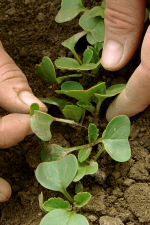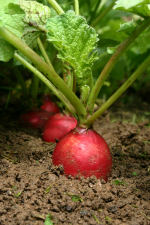Radishes come in all sizes and shapes including long like a carrot but the most common are the red, round radishes which are generally eaten raw.
Radishes grow really quickly and can be grown successively in the vegetable garden all year round. They are also delicious in salads because they add a crunchy texture and a flavour that is a little bit hot and spicy. Not everyone enjoys their unique flavour but they are definitely worth trying as the taste is quite unlike any other vegetable.
PLANTING
Prepare the garden bed by removing the weeds and then digging through plenty of compost. Water the soil and then use a dibbler or large stick to make small holes about 20cm apart. Place one seedling in each one and gently push the soil around the roots. Water lightly.
Radishes also grow really well in pots that are only about 20cm deep. Fill the pots with premium potting mix, plant the seedlings and water them lightly. Make sure that the pots get at least 6 hours of daylight and don’t let the potting mix dry out.
CARE AND MAINTENANCE
Water the seedlings regularly so that the soil doesn’t dry out and apply liquid fertiliser every two weeks. Mulch between the rows to prevent weeds from growing as these might smother the small leaves of the radish.
If the radishes start to pop up above the ground, don’t worry too much as this is quite normal. There’s no need to cover them back over.
HARVESTING
Radishes are so fast to grow that they could be ready to eat in as little as three weeks. Pull one out to see if it is the size that you are after and if so, pull out the rest when you need them. A globe radish that is about 2 to 3cm across is about right but don’t leave them in the ground to get too big as they get old and tough.
HOW TO EAT
Use a small knife to top and tail the radishes which means to cut off the point where the roots were and then cut off the leaves; all that will be left is the round, red radish. Wash the radishes and serve them whole on a platter with other salad vegetables or cut them into quarters or slices to mix through a tossed salad. Find great recipes on the Smarty Plants Kitchen.
HOW THEY GROW
A radish seedling grows very fast. Within a few weeks of being planted, the leaves above the ground grow larger whilst a bright red ball, about the size of a ping pong ball, forms under the ground. The radish has tiny fibrous roots attached and one root from the bottom which helps the plant take up the water and the nutrients that it needs.
FAST FACTS
Botanical Name: Raphanus sativus
Life Cycle: Annual
When to Grow: All year round
Height/Width: 20cm x 10cm.
Requirements: Plant in full sun and water every day unless it rains. Liquid fertilise fortnightly.
Nutritional Benefits: Radish contain small amounts of vitamins and minerals but you would have to eat a lot of them to benefit.




